We live in hell.
Now, I know that seems like hyperbole, but it’s just the truth. We live in hell. And it’s a hell of our own making. I don’t mean me and you. I mean, humanity in general. We’ve built this hell from the ground up. I think it’s important to establish that fact because I find a lot of people — from grown adults to my 17-year-old students — don’t understand this very simple fact: We made the world the way it is. This very simple fact has done a lot to ground me in the last 20 years of my life. Because the way I see it is that anything that has been made can be unmade or destroyed or reconstituted with effort, care, and the belief that we can actually unmake shit if we want to.
I think, as Americans (and maybe as “Westerners” in general), we have a tendency to believe our history should always be moving forward towards some better state. We’re afraid to look back because it reveals what is true about all societies and civilizations: The road towards equity is often extremely dark and filled with the kind of nightmarish acts we cannot possibly begin to understand or make amends for. In the U.S., especially, we look at our history as an example of the march towards progress, so we celebrate where and when our “heroes” win. We often gloss over the cost of winning and what winning actually looks like, and we never really examine what made that march possible in the first place. History isn’t necessarily taught to us as a collection of deeply human acts done by groups of deeply human people. When it comes to the terror we’ve wreaked on each other, the story generally goes like this: Once, we thought [insert any grotesque institution, such as slavery for instance, here] was totally within our rights, and then, we realized it actually wasn’t.
It’s a trick, you see? If they don’t elaborate too much, then they get out of explaining a few things. First, who is responsible for the change in the moral consensus and how they came together to do it. Second, what lengths they went to to resist, fight back, and attempt to remake our society. And third, the lasting effects of the institutions themselves. Or the exact opposite is true. Sometimes, we pay so much attention to the darkness, it’s hard to see where any “progress” has been made at all. Since we often aren’t taught to study the ways people resisted beyond the little snippets we get about the Civil Rights Movement, it almost feels countercultural to do so. The history of resistance in the U.S. — from the Bread and Roses Strike of 1912 to the East Los Angeles Walkouts in 1968 to ACT UP’s work throughout the 1980s and 1990s — is often either completely omitted or obscured in some ways so as to make it seem like it wasn’t as monumental as it’s been. Resistance is boiled down to a few people doing a few things to get a Congressman or two to introduce a law that will “change everything.”
As people are organizing against the genocide in Gaza and as the backlash to the call for carceral abolition and LGBTQ rights rages on in the U.S., it’s more apparent than ever that the majority of people, even some of the people who call themselves “radical,” are severely lacking in the political education necessary to fight against the forces that want to keep this hell the way it is. As is usually the case during Pride month (and most of the year, if I’m being honest), I’m thinking about what liberation actually looks like, what it means to achieve it, and putting in work to make the liberation viable even if I’ll be dead before it happens. Often, because we’re given such a watered-down version of movement history, we don’t really take the time to sit and genuinely consider that work. Liberation, for any oppressed people, can’t be negotiated at a table with a group of representatives from each side and a mediator. Liberation doesn’t happen through a set of agreements drawn up in a way that will please everybody at this imaginary table. Liberation is hard won and hard fought for, often through a series of events that would make a lot of people’s skin crawl. The tactics necessary for truly fighting back against our oppressors are violent, confrontational, combative, and completely unconcerned with how they’ll be viewed in the press (or these days, on social media) or by the population at large. As a result, many people distance themselves from movements that utilize these demonized tactics.
Since it’s Pride month, I have to point out what a betrayal of Pride that distance is. We always say, “The first Pride was a riot” and it’s become a kind of cutesy catchphrase that has seemingly given all of our Pride celebrations since the Stonewall Riots of 1969 meaning instead of the call to action it should always be. Really, I’m not sure how often people are actually thinking about the events of that night. But it’s called a “riot” for a reason. It was violent, confrontational, combative, and completely unconcerned with what might happen the following day. Of course, in a lot of ways, it seems unavoidable, because the police who came that night to raid the bar were there to run out its clientele by any means necessary. But the truth is, the queers and queens hanging out at Stonewall that night made a choice. They chose to fight back by any means necessary. If that meant losing their lives, getting severely injured, getting arrested, being outed to their families and associates, or any other consequence you could possibly think of, they took the risk. Not because it was easy or because they didn’t have any other choice, but because it was right. Standing up for themselves and for other queer and trans people was a moral obligation they didn’t shy away from.
We’re supposed to look back at the Stonewall Riots during Pride month because it was one of the most high-profile moments that helped galvanize the gay rights and LGBTQ rights movement in the U.S. At the same time, what happened that night has become so sanitized and anesthetized in the public eye that it’s also become the extent of many people’s “radical” queer education. People often forget there have always been queer and trans people from every corner of this country fighting to unmake the hell we’re living in and that, like Stonewall, their tactics went far beyond calling their Congresspeople and having a giant party sponsored by Bank of America and regulated by the municipal police. That moral obligation to fight until we win has been part of the queer and trans liberation movement for longer than many of our grandparents have been alive.
I’m confident the archives are filled with hundreds, if not thousands, of stories still waiting to be uncovered. But when I think of how to model my own resistance and resilience, there are a number of stories from before Stonewall (and one right after) that we do have access to that I think of all the time aside from Stonewall and the extremely courageous (and once again, combative) acts of the members of ACT UP during the AIDS crisis. Some of these stories are small acts of resilience and revolution that only impacted a hyperlocal community of queer and trans people and the people they fought against. Others are larger acts of resistance that challenged not only the members of their communities who were against them, but also their local police or local governments. Many, if not all, of these attempts to unmake and remake these communities included tactics often demonized by the status quo, and most importantly, they show the power of undaunted and intrepid organizing.
La Paloma Stays Open — Miami, Florida, November 1937

You read that date correctly. As early as the 1930s, queer people in South Florida were fighting for their rights to exist peacefully and party however they hell they want. This little forgotten piece of queer resistance history is one that shocks a lot of people when they find out about it. La Paloma was a gay bar that hosted drag queen shows and strip shows that operated in a part of unincorporated Dade County during an interesting moment in Miami history. At the time, Miami was just being touted as a tourist destination, and local police were somewhat lenient about much of the city’s not-so-underground illegal activities. Unsurprisingly, this led to backlash from locals who wanted to keep the city “clean” and free of “vices.” In November 1937, a group of locals who made up the Miami chapter of the Ku Klux Klan set its sights on La Paloma specifically because of queer events and clientele.
On the night of November 15, they raided the bar, destroyed some of it, and beat up people who were there. According to a news story printed after the raid, the Klansmen claimed they conducted the raid because people in the community were scared of La Paloma’s owner Al Youst and didn’t want to file a complaint in court against him and the bar. After the raid, the Dade County Sheriff took action to try to keep the bar closed, but that only got the bar’s patrons and Youst more organized and more determined to keep the bar open. La Paloma stayed open despite constant harassment from the local police, and the bar’s manager introduced new entertainment that was “spicier than ever,” including a skit making fun of the Klansmen who originally raided the bar.
Pepper Hill Club Raid Resistance — Baltimore, Maryland, October 1955
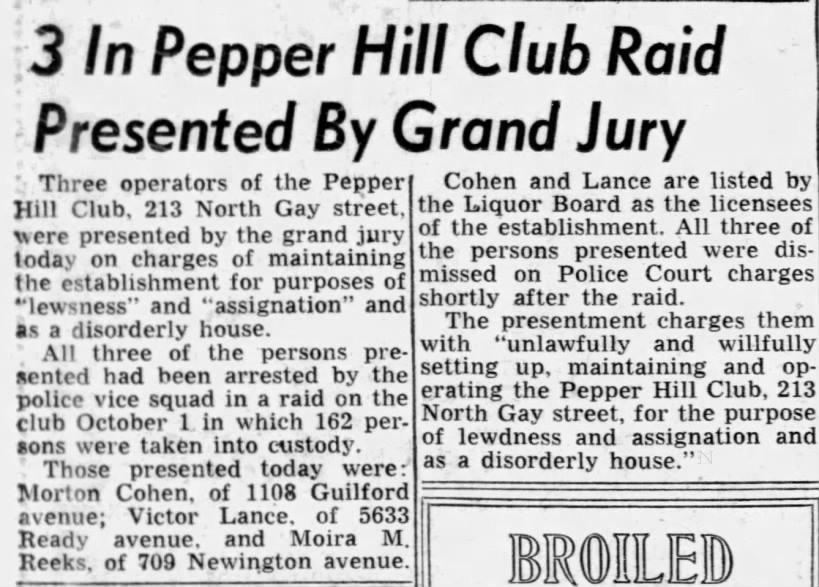
Fri, Oct 07, 1955 ·Page 52
This one is particularly interesting, not because of the exact events of the night of the raid but because of what happened the next day when 139 of the 162 people who were arrested had to show up for court. But before we get there, a little background: The Pepper Hill Club was a nightclub that attracted mostly queer patrons in an area of Baltimore filled with strip clubs and peep shows. Funnily enough, it was located on North Gay Street, though the street was unfortunately named for some guy, not for us. Anyways, on the night of October 1, the Baltimore Police Vice Squad raided the club and were met with a “living wall” of patrons — the place was packed and people were not cooperative. Regardless, the police ended up arresting 162 people (that’s 148 more people than were arrested at Stonewall).
Interestingly, when the people who were arrested had to show up in court the next day, they were joined with a large group with dissenters. According to a newspaper report published the following Monday, “the court session was a wild climax to a wild night.” There isn’t enough information available to know for sure what went on, but it appears enough people were outraged and not afraid to share that outrage at the risk of being arrested for contempt of court themselves. Their outrage in the courtroom that day got the judge to release all but five of the people who were arrested.
The Black Nite Brawl — Milwaukee, Wisconsin, August 1961
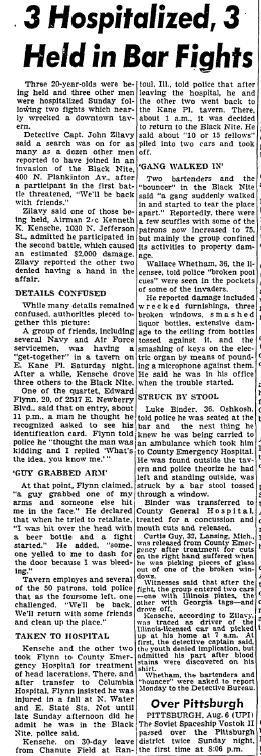
Although much of the queer resistance on this list happens directly against the institutions that make it hard for queer and trans people to live, this moment was about queer and trans people standing their ground against other community members who sought to inflict violence against them. In Wisconsin in the 1960s, it was not only illegal for queer and trans people to congregate in bars, but it was also illegal for those bars to serve alcohol to anyone identified as or suspected to be queer or trans. This meant there were no “public” gay bars, so the ones that existed did so in secret or by making sure they also had other clientele in the building at all times. The owner of The Black Nite, Wally Whetham, along with a Black gender non-conforming person named Josie Carter and Josie’s husband didn’t give a shit about the law and ran the Black Nite as a spot for mostly queer and trans clientele instead of a place that simply tolerated them.
On August 5, 1961, a small group of Navy servicemen went to the Black Nite “on a dare” and were refused entrance by Josie’s husband, who was the bouncer at the time. They tried to jump the bouncer, so Josie intervened with beer bottles to fend them off. This incensed the servicemen who went back to the bar they were originally at to recruit others to raid the Black Nite. By the time they got back to the bar, it was at full capacity, and Josie had already spread the news of what happened earlier. According to reports, every patron in the building was prepared to fight the servicemen when they returned, and fight they did, until the entire inside of the bar was destroyed.
Although the police shockingly arrested only the servicemen and their friends when they eventually showed up to the brawl, this story unfortunately doesn’t have such a happy ending because Whetham was forced to change the bar entirely afterwards. However, I do think it stands out as a moment where queer people held their own against the threat of violence by fighting against it the only way they knew would work.
Emma Jones Society Beach Parties — Pensacola, Florida, 1965 – 1969
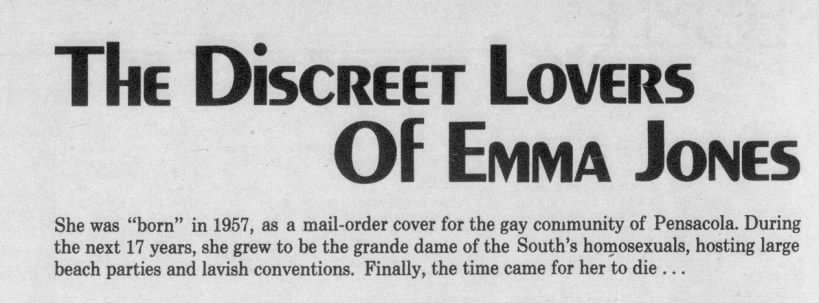
Sun, Mar 16, 1975 ·Page 282
If you didn’t know, Florida was kind of a gay paradise in the first half of the 20th century, so much so that by the 1950s, a “gay panic” began in the state because of a 1954 Miami media campaign that revealed the scale of the queer population living there at the time. As a result, anti-queer hostility was rising in the state and made it even more difficult than it already was for queer people in Florida to communicate with each other, read queer publications, and gather together.
But partners Ray and Henry Hillyer didn’t let that stop them from committing mail fraud and eventually starting what is probably the earliest analog we have to modern Pride celebrations. In the late 1950s, the Hillyers opened a P.O. Box under the pseudonym “Emma Jones” so they could receive and distribute queer publications to their friends and other queer people in the Pensacola area. They started by having gatherings at their home — aptly named the “Emma Jones Society” — where other queer people, mostly gay men, could come socialize and get the magazines they were ordering to the P.O. Box. By 1965, the crowd of people interested in the Emma Jones Society had grown, and the Hillyers were determined to keep the party going.
On July 4, 1965, the Hillyers and their friends threw the first Emma Jones Beach Party on Pensacola Beach. They picked that day specifically because they figured they would be more inconspicuous amongst the crowd of beachgoers that show up for the holiday. They invited 50 people to the party, but 100 showed up. The following year, that number ballooned to 600, despite the limited number of invitations sent out. By 1969, the local police were on to the secret and shut down the party, citing the anti-gay laws in effect at the time as the reason why. However, the Hillyers, once again, weren’t deterred by this. Instead, they created the Emma Jones Society Convention and found a local hotel willing to host it for the next five years until the 1970s attacks on queer people and backlash from the larger Pensacola community made the event too dangerous to keep hosting.
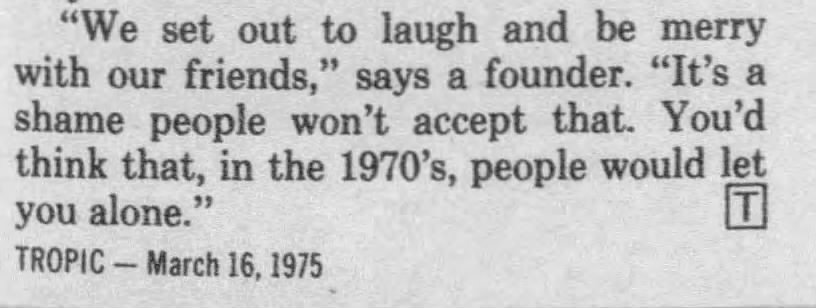
Sun, Mar 16, 1975 ·Page 303
Bucks County Community College Censorship Protests — Newtown, Pennsylvania, May 1968
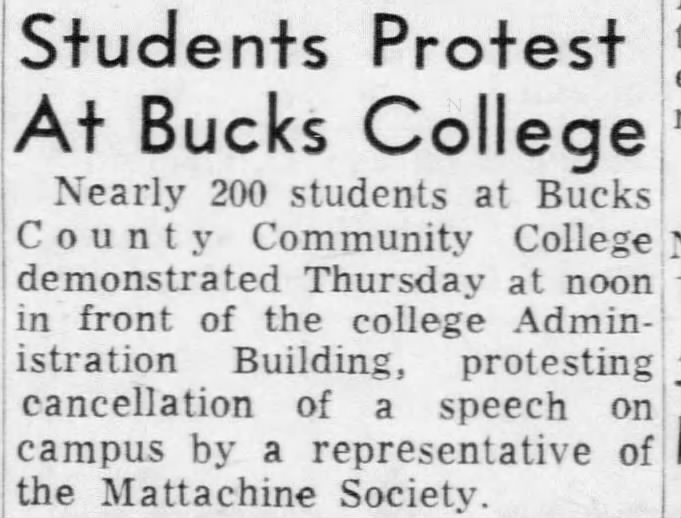
Fri, May 10, 1968 ·Page 35
This one is an important “twofer” because it’s not only representative of pre-Stonewall queer resistance, but it’s also an incredible example of student-led resistance on a college campus (which, as we know, is a pertinent topic of conversation right now). In addition to that, this one really sticks out to me because it didn’t take place in a big city. Rather, it happened in a smaller city outside of Philadelphia. In the spring of 1968, the Cultural Committee of the Bucks County Community College student government arranged to have Richard “Dick” Leitch, the president of the New York chapter of the Mattachine Society who was known at the time for challenging New York City’s ban on serving queer people in bars, come speak at BCCC on his activism, experiences, and the state of the fight for gay rights in general. At the last minute, the school’s administration canceled Leitch’s appearance and decided they would let faculty members at the school — not queer faculty members, mind you — discuss the topic in open forums.
In what became an alliance of both queer and non-queer students, a group of around 200 students participated in a walk-out on May 9, 1968 to protest the college’s decision to cancel the lecture. The students charged the administration with “censorship, inhibiting intellectual growth, hindering the pursuit of inquiry and being pressured by religious and political forces.” Although the walk out only lasted that day, the following month was filled with different kinds of student organizing that eventually led the college’s Board of Trustees to institute a committee and a set of policies that would ensure more “democratic” handling of the students’ rights to academic freedom from that point on.
Ansley Mall Mini-Cinema Raid Resistance — Atlanta, GA, August 1969
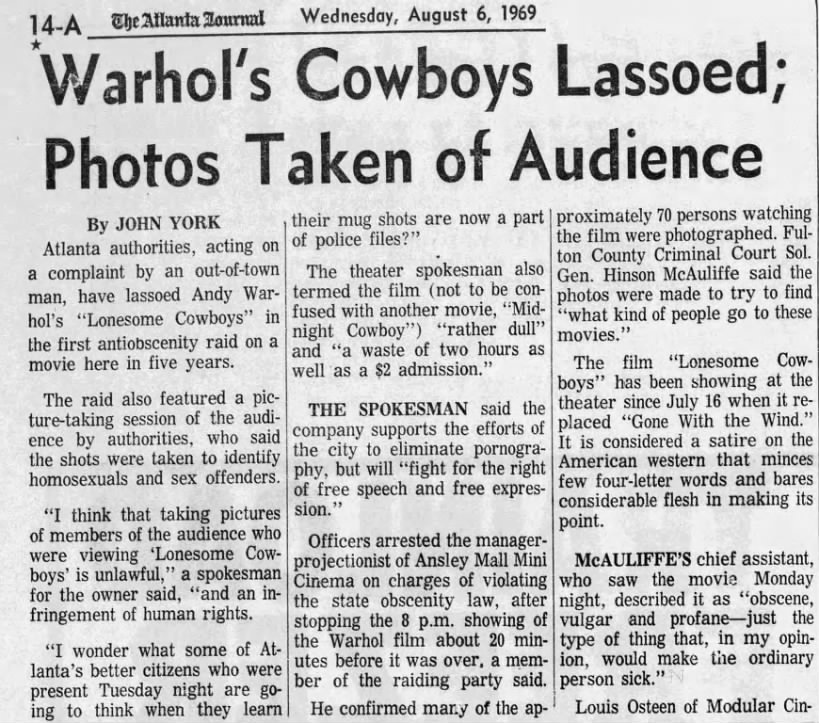
Wed, Aug 06, 1969 ·Page 14
Happening only two months after the Stonewall Riots, the Ansley Mall Mini-Cinema Raid is another example of little known queer resistance history that actually led to the organization of a community where there wasn’t organization before. During an August 5 showing of Andy Warhol’s very homoerotic Lonesome Cowboys at the Ansley Mall Mini-Cinema, a group of Atlanta police officers raided the theater to enforce the city’s obscenity laws and harass the queer people they knew would show up for the screening. Many of the screening attendees were arrested and documented as “known homosexuals.”
A few days later, a group of people organized a small protest in response to the police violence and the raid at the offices of Atlanta’s alternative newspaper, The Great Speckled Bird. At the protest, they demanded to “Get the pigs out of our community,”, and the police responded by macing and arresting many of the people there. Both the raid and the police’s response to the protest set off members of Atlanta’s gay community who committed themselves to more organization and escalated tactics. In a meeting led by Bill Smith and Berl Boykin, organizers started the first Georgia chapter of the national Gay Liberation Front. Their first actions included organizing protests against the state’s anti-sodomy ordinances and getting queer and trans people registered to vote.
Then, against the laws of the state and the city, they organized Atlanta’s first Pride march in 1970. According to reports, 125 people showed up to the march despite the threat of police violence and marched up Peachtree Street to protest the municipal government and bring awareness to the fight for queer rights in the city and state. The raid and the events that followed have been referred as the “Stonewall of the South” because even though the Stonewall Riots helped galvanize the queer rights movements in the Northeast and the West, it was the Ansley Mall Mini-Cinema raid that strengthened queer rights organizing in the South.
In a moment when trans people, especially, are being stripped of access to care and our movements against imperialism and genocide are being criticized by our enemies and their collaborators, I think we should be using Pride to uncover these stories, look back at these moments, learn from them, and, perhaps, channel some of their bravery to change the ways we show up to fight. Those who came before us believed they could unmake the world with a lot fewer tools at their disposal. What’s stopping us from committing ourselves to doing the same?



incredible work, Stef!
Brilliant article, thank you! Sending this to my friends.
Thank you, thank you for this history can call to action!
This is excellent, thank you.
Excellent work! A great introspective!
Thanks for these interesting stories, but, with respect, all involved resistance to some degree only one could possibly qualify as an “uprising.” “The difference between the almost right word and the right word is really a large matter; ’tis the difference between the lightning bug and the lightning.” – Mark Twain. And “History” has not tried to “hide” them. They simply disappeared along with a zillion other stories about a zillion other topics over time. We are genuinely victimized enough without claiming this is an example of it. “. . . galvanize the gay rights and LGBTQ rights movement in the U.S.”??? When did the “G” in “LGBTQ” stop meaning “gay”? Thanks.